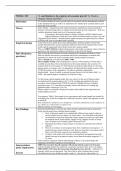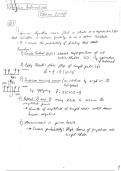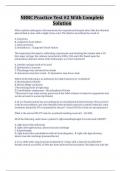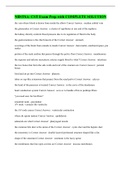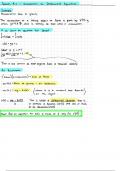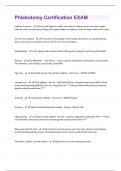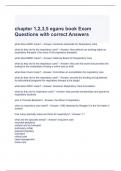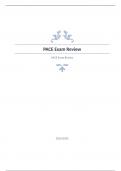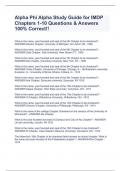Gregory, Romer and Weil
Motivation To examine whether the Solow growth model is consistent with the international variation
in the standard of living as well as its implications for whether poor countries tend to grow
faster than rich countries.
Theory Solow Model – Exogenous growth model assuming a standard neo-classical production
function with decreasing returns to capital (saving and pop. growth exogenous) – these two
variables determine steady-state level of income per capita.
- Convergence: decreasing returns to capital, countries with little capital means
higher preliminary returns and every initial investment makes you grow very fast
Augmented Solow Model – Includes human capital and physical capital (may be evidence
of OVB as HC may be correlated with S and PG).
Empirical design Using OLS (assess capital share using implied alpha), splitting samples into the three
groups illustrated below and measuring the difference between the original Solow model
results and the augmented Solow Model results (inc. human capital).
This is a STRUCTURAL method (starting point is the model, you plug in values of known
parameters and calibrate the unknown parameters so that it fits the theory)
Data (frequency, Data is from the Real National Accounts constructed by Summers and Heston (1988)
questions) Data set includes real income, government and private consumption, investment and
population for almost all of the world other than centrally planned economies
Data is annual and cover the period 1960 – 1985
Three samples of data: most comprehensive consists of 98 countries for which data is
available (except those where oil production is their main industry), the second are 75
countries that received a grade ‘D’ from Summers and Heston (data based on very little
primary data) or countries with <1m population, the third and final sample consists of the
22 OECD countries with a population >1m (data is uniformly high quality)
Implied alpha – share of capital in national income (known to be less than a third) – in
Table 1 the implied alpha is completely off with 60% citing.
For the human capital adapted model, they use a proxy for the rate of human-capital
accumulation that measures approx. the % of the working age population that is in
secondary school obtained from UNESCO yearbook. Multiply fraction of eligible
population (ages 12-17) enrolled in secondary school with fraction of working-age
population that is school age (15 to 19).
Human capital is correlated with physical capital (when added in the regression); the
implied alpha goes down
Convergence: Table 3; first sample is just convergence and second sample you control for
everything else. In the first sample the coefficient is positive which is the opposite of what
it should be
Rule of thumb for standard errors (multiply by 2 and then add/subtract to the coefficient to
see whether it is still positive or negative etc)
OECD countries are converging.
Key Findings International differences in income per capita are best understood using an augmented
Solow growth model (one including human capital)
1. Stock of physical capital is not substantially different from capital’s share in
income (capital receives approx. its social return – not substantial externalities)
2. Accumulation of physical capital has a larger impact on income per capita than
the textbook Solow model implies. Higher saving higher income in steady
state higher level of human capital increases TFP
3. Population growth has a larger impact on income per capita than the textbook
indicates
4. There is no evidence of convergence (they show conditional convergence) – if
production has constant returns to scale, then you must have convergence and if
there is no CRS, there cannot be any competitive markets
5. Countries with similar tech and rates of accumulation and population growth
should converge in income per capita, slower than the textbook suggests (17 vs
35 years)
Solow model is consistent with the international evidence if one acknowledges the
importance of HUMAN capital as well as physical.
Interpretation/ MRW does not show that all countries will end up with the same level of income –
policy implications with the standard model, the coefficient was positive and shows they aren’t converging.
MRW DOES NOT show that increasing schooling increases growth – implication of
causality which was not discussed. They show that in richer countries there is more
EXAM schooling but also more healthcare, parks, roads etc – they haven’t shown that it is
,QUESTIONS definitely schooling that increased growth – it could be healthcare that does it.
WEEK 1 MT ‘Worms: Identifying Impacts on Education and Health in the
Presence of Treatment Externalities’ by Miguel, E and Kremer, M
Motivation Examine the impact of program in which 75 rural Kenyan primary schools
were phased into deworming treatment in a randomised order.
Theory Studies that have already been done may doubly underestimate the
benefits of the treatment, missing externality benefits from reduced disease
transmission – evaluate a Kenyan project that tries to accurately represent
the benefits of treatment.
Randomly phased into a school-based mass treatment instead of
individual-based (allowing the estimation of the total programme)
Empirical design Cross-school externalities – using exogenous variation in the local density
of treatment school pupils generated by the school-level randomization.
Within-school externalities – we can’t full account for this effect due to
the nature of the study being randomization by school not individuals.
Data (frequency, o Study occurs across 75 schools in Busia Kenya
questions) o 92% of children in school have some worm infection at baseline
o Schools are divided into three groups:
Group 1 is treated in 1998
Group 2 is treated in 1999
Group 3 is treated in 2001
o Schools randomly assigned to the three groups to avoid
attrition bias
o Use group 2 & 3 as a plausible counterfactual for what would have
happened to group 1
Worms:
- Infect approx. 1.3bn people per year
- Re-infection rates are high, and cost of treatment is low
- Spread through open defecation or physical contact – eggs can
survive in fresh water and can infect people who drink/bathe in it
Key Findings o Treatment reduced infection by 40% (23pp)! This is much higher
than we would estimate without incorporating externalities
o A reduction of one infection per child
o Increase of 0.14 years of schooling after treatment of one student
o Reduced absenteeism by at least 0.25, with particularly large
participation gains from younger children
o Cross-school externalities
o No evidence that deworming increases academic scores
Interpretation/ What factors could cause the effect of the program to be larger/smaller in
policy implications other contexts?
- Density of schools
EXAM - School attendance rates
QUESTIONS - Sanitation norms
- Politicization of vaccines
Disability-Adjusted Life Years – measure both the years lost and the
quality of life lost due to illness
- Deworming program saved 649 DALYs
- Per-pupil cost of deworming a child is approx. 0.49 USD
- Cost per DALY saved is approx. 5 USD
, - 76% of the benefits come in the form of externalities!!!
Beyond GDP?
WEEK 2 MT
Welfare across
Countries and
Time`
by Jones C., Klenow
P.
Beyond GDP?
Welfare across
Countries and
Time`
by Jones C., Klenow
P.
‘Beyond GDP? Welfare across countries and time’ by Jones, Klenow
To compare living
Motivation
standards of people
in different
countries taking
, into account
welfare
measures such as
consumption,
leisure, inequality,
and mortality using
the standard
economics of
expected utility.
To compare living standards of people in different countries considering
welfare measures such as consumption, leisure, inequality, and mortality
using the standard economics of expected utility.
Special Settings GDP is a flawed measure of economic welfare as many factors affect
living standards within a country that are incorporated imperfectly, if at
all, in GDP.
Theory Compare welfare across countries using a common specification for
preferences. A utilitarian expected utility calculation giving equal weight
to each person. The welfare metric could be an equivalent variation (by
what proportion to adjust to equal welfare) and a compensating variation
(by what factor to increase to raise welfare) producing different results
especially for poor countries – paper reports the equivalent variation.
Empirical design Calculate consumption-equivalent measure (λ) of welfare to see what
proportion of consumption in one country, given its values of these
factors, would deliver the same expected utility as values in another
country and make an individual indifferent between two countries.
It is assumed that utility from leisure takes a form that implies a constant
Frisch elasticity of labour supply (holding the marginal utility of
consumption fixed, the elasticity of labour supply with respect to the wage
is constant)
Various existing data sets (Penn World Table, UNU-WIDER World
Income Inequality Database etc) are used for data for a much wider set of
countries. Evidence suggests that calculations using publicly-available
multi-country datasets are potentially informative as they closely match
the results derived from extensive data for the 13 aforementioned
countries.
Data (frequency, Detailed micro data from household surveys for 13 countries to provide a

